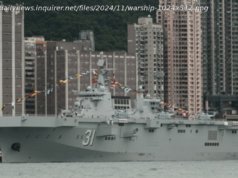Beijing is a potential enemy on a number of fronts
One wonders what went on in Russian minds during last month’s spectacle of US President Trump raking Beijing over the coals on accusations of meddling, in the upcoming US midterm elections, to try to undermine his trade policies.
Certainly the Chinese, who evidently didn’t expect it, were shocked and outraged, but it was behavior to which Moscow was accustomed to being on the receiving end of – this time aimed at someone else for a change.
Geng Shuang, China’s Foreign Ministry spokesman, called Donald Trump’s claims “totally far-fetched and fictional,” and advised the “US side to stop its unwarranted accusations and slander against China and refrain from wrong words and deeds that might hurt our bilateral relations and fundamental interests.”
Undeterred, Vice President Mike Pence picked up the same theme earlier this month, even accusing Beijing of what amounts to an effort at regime change in the United States: “China has initiated an unprecedented effort to influence American public opinion, the 2018 elections, and the environment leading into the 2020 presidential elections,” said Trump’s No. 2. “To put it bluntly, President Trump’s leadership is working; and China wants a different American President.” Beijing called the charge “ridiculous” and “malicious slander.”
Some observers, such as Harry J. Kazianis of the Center for the National Interest (“The Coming American-Russian Alliance Against China”) and former Indian diplomat M. K. Bhadrakumar suggest his is part of a long term strategy (“Trump Has a Grand Strategy, He Wants to Do a ‘Reverse Nixon’ – Partner Russia for an Alliance vs China”) and see the new US verbal belligerence against Beijing as evidence that Washington intends a shift in “triangulation.” This, as they see it, would mean a flip of Nixon’s pivot to Beijing against Moscow, this time with the US cozying up to Russia to take on China.
Clearly, they’re at least half wrong. Washington can’t woo Moscow on the basis of the unremitting hostility, threats, sanctions, and provocations – always increasing, never decreasing. Also, given past broken promises, for example on NATO expansion, the Russians would have no reason to trust any American overtures, which aren’t being made in any case. Also, as neighbors with a 2,500-plus mile border and a lot to gain by cooperation, notably in Eurasian economic integration, Russia and China have more incentive to work with each other than either has with the US, plus every reason to avoid hostility at the behest of a power on the other side of the world.
But the “triangulationists” are also half right in their perception of the thinking of the US policy making class: China indeed is rapidly entering the category of prospective enmity of the sort with which Washington has long regarded Russia (and which in fact never really stopped with the end of the USSR).
Some analysts, such as Caitlin Talmadge, a security expert at Georgetown University in Washington DC, writes in Foreign Affairs that a war between the two countries is currently unlikely, but “no longer seems as implausible as it once did… The odds of such a confrontation going nuclear are higher than most policymakers and analysts think.”
While Secretary of Defense James Mattis’ recent trip to China may have been aimed at mitigating the risk of an inadvertent clash between US and Chinese forces, it can’t have done much to reduce the impact of deliberate policies designed to preserve US hegemony in the western Pacific – and globally.
Whether or not Trump himself inclines in this direction, there is no question that this is the vector of the US establishment. As described in the January 2018 National Defense Strategy, the pretense that combating Islamic terrorism is the guiding star of US policy is out, and what Mattis dubbed rivalry in a new “great power competition” is in. This means the US against Russia and China, in that order.
Nothing more needs be said here with regard to Russia’s effectively permanent adversary status. But with respect to China, this means treating Beijing as a potential enemy on a number of fronts, especially if it involves Chinese cooperation with Russia. (The counterproductive impact of pushing Russia and China even closer together is evidently lost on US planners.)
For example, in September, Washington slapped sanctions on the Central Military Commission of China because of its purchase of 10 Russian Su-35 and equipment for surface-to-air S-400 missiles. Ostensibly, the action was triggered by a Chinese violation of US sanctions against Russia for 2016 election meddling, but the real issue is China’s strategic relationship with Russia.
This does not mean there are not different priorities on China within the US establishment. Even within the Trump administration, the “trade hawks” are largely internally focused on the US economy and industrial base; what they mainly seek is a change in the US trade relationship with China. Conversely, the neoconservatives and national security hawks who dominate Trump’s national security team see China as a rising strategic foe (comparable to their view of Russia) but at a more distant future point.
The trade hawks are happy to support the security hawks’ anti-China initiatives not because they particularly care about them but because they see them as pressure to “soften up” Beijing on trade. These pressures include continual air and naval prodding in the South China Sea; trying to undercut the Belt and Road Initiative (BRI), which also likely includes covert proxy support for jihadists in Xinjiang and Myanmar’s Rakhine State; and finding an excuse to maintain a military presence on the Korean peninsula. Trump’s national security team is skeptical of his Korea policy, because of the fear that Pyongyang won’t denuclearize, and even worse that it might, depriving them of an excuse to keep US troops on the East Asian mainland as a counter to China and Russia and will link South Korea up with BRI.
Conversely the security hawks care little about trade (except to the extent they see China’s surplus as a boon for military production) but welcome a tariff war as a way to squeeze Beijing’s economy and, hence, its military capacity – which is perceived as such by the Chinese.
While these factional perspectives diverge, they end up in the same place: continued pressure on China. While some productive “art of the deal” outcome might be Trump’s preference, it’s difficult to see how that can happen.
Beijing will also be a key target with the upcoming tightening of sanctions on a number of countries continuing to do business with Iran. This will mean not just China but also Turkey and possibly India. (India is a special case because of Washington policymakers’ efforts to woo New Delhi as the linchpin of the so-called “Indo-Pacific Quad” intended to contain China.) But the most important targets will be countries of the European Union. Much is being made of a so-called “clearing house,” or Special Purpose Vehicle (SPV) for conducting business with Iran to avoid the SWIFT system and US sanctions.
The SPV concept is supported by the European Union, the United Kingdom, France, and Germany, as well as China and Russia. Simply the suggestion of the SPV mechanism has infuriated Washington, because it not only signals a possible shift by Europe from Washington’s “Transatlantic” yoke, it means betting their economic future on cooperation with Russia and China. (It should also be kept in mind that the US Treasury Department can simply sanction the SPV clearing house itself, applying secondary sanctions to any European companies that interact with it.






